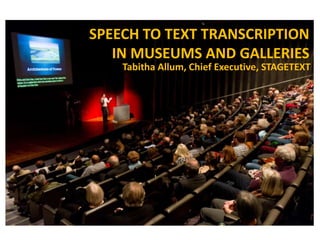
Speech-to-text transcription at National Museums Liverpool presentation 12.2.14
- 1. SPEECH TO TEXT TRANSCRIPTION IN MUSEUMS AND GALLERIES Tabitha Allum, Chief Executive, STAGETEXT
- 2. About STAGETEXT • Founded in 2000 following trip to London by some deaf New Yorkers where they brought captioning with them • 5 of our 9 Trustees and 2 of our 6 staff members are deaf, deafened or hard of hearing • Receives regular funding from ACE, project funding from trusts and foundations but also charge direct costs to venues • Started in theatre, now expanding to offering speechto-text in museums, galleries and literary events
- 3. What is speech-to-text for talks? • Palantypist or stenographer is used to transcribe what is being said using phonetic keyboard • Text is displayed at the front of the auditorium for talks and on handheld displays for tours
- 4. Who is captioning for? • There are 10 million people in the UK with varying degrees of deafness (by 2031, it’s estimated to rise to 14.5 million) • More than 70% of over 70 year-olds and 40% of over 50 year-olds have some form of hearing loss • At least four million people who don't have hearing aids would benefit from using them • On average it takes ten years for people to address their hearing loss • Over 99% of people with hearing loss do not know British Sign Language Statistics: Action on Hearing Loss
- 5. How does captioning help?
- 6. Static talks • Palantypist or stenographer (STTR) is present or remote • Text is either displayed on separate screens or integrated with main presentation using multimedia scaler
- 7. Tours using handheld devices • Audio taken from tour guide • Audio sent to remote STTR • Transcription sent to a webpage • Patrons read the text on a wifi-enabled tablet as they walk around the exhibits
- 8. Results from feedback card exercise Those patrons who declare to be using the text and those who are the ‘incidental’ patrons who find it useful Name of Venue Total number of people attending % of audience who booked to use the text % of total audience which “found text useful” at the end National Gallery (Talk) 108 19% 73% Wellcome Collection (Talk) 90 18% 62%
- 9. Beyond access? • Not just deaf, deafened and hard of hearing people who find it useful “The conference was my first experience of speech-to-text and I thought it added greatly to the speakers’ delivery and our comprehension of their talks... Hearing but also seeing the words helped me focus and concentrate all the more on the presentations.” • The impact of speech-to-text on engagement and deepening understanding needs to be investigated
- 10. What we need from speakers Glossary of key words that the speaker will use, for example: o Titles of works, proper nouns, places o Unusual vocabulary that the speech-to-text reporter will not have in their dictionary: eg Theocentric, Anthropocentric, Humanism, Worpswede, Grèz-sur-Loing o Any quotes or excerpts from books, films or writers o If not prepared in advance, words may appear phonetically: – Canaletto = can let toe – Euripides = you’re rip deeds o Speaker’s PowerPoint presentations, if possible
- 11. Moving the service on • Started providing the service in London • Now looking to expand into other major cities, like Liverpool • Growing the audience of deaf, deafened and hard of hearing patrons • Investigating impact on engagement among the incidental users – making a better case • Would you like to join us….?
- 12. Thank you for listening www.stagetext.org @STAGETEXT tabitha@stagetext.org